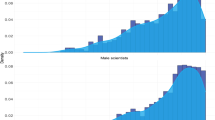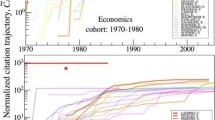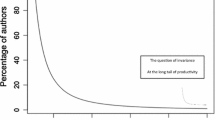Abstract
This paper defines the ‘miraculous year’ as the most productive year in academics’ scientific careers. It tests the hypothesis that annual productivity is unevenly distributed with a Lotka-like distribution at both individual and group levels. To gain generalizability, we model distributions of annual publication productivity in three independent mini studies. The studies include Israeli star scientists, highly cited physicists, and economists in an elite American university. The findings show that most scientists enjoy a peak annus mirabilis with a minority having a few such peaks. Academic age at which the annus mirabilis takes place gravitates towards the center of a career, especially amongst older scientists. The results support the hypothesis that scientific careers are punctuated by exceptionally productive years. We discuss how administrative constraints may affect levels of productivity. The paper opens up a new empirical domain for further empirical tests of career productivity and calls for policy discussions around the implications of the idea of the annus mirabilis.



Similar content being viewed by others
Notes
We concentrate on annual productivity in terms of work output, simply measured by number of publications. We cannot estimate ‘novelty’ or ‘impact’ in this context. We devote some thoughts about the latter in the “Discussion”.
We cannot devote space for the related literature concerning artistic age and creativity, or with life cycle effects on quality of work in painting, poetry, literature or film (for an example see Galeson 2006). We are not concerned with quality but with the quantity of scientific outputs (i.e., number of publications per year).
Due to privacy regulations we cannot provide the name of that university. Suffice to say that it ranks at the top ten institutions in world rankings.
Israel mandates retirement for faculty at age 68, though universities allow exceptional scientists to maintain research labs with reduced support.
For those with multiple years with an equal max number of publications, we used their age at their first year with the max for the regression.
References
Abramo, G., D’Angelo, A. C., & Murgia, G. (2017). The relationship among research productivity, research collaboration, and their determinants. Journal of Informetrics,11(4), 1016–1030. https://doi.org/10.1016/j.joi.2017.09.007.
Angrist, J., Azoulay, P., Ellison, G., Hill, R., & Susan Feng, L. (2017). Economic research evolves: Fields and styles. American Economic Review,107(5), 293–297. https://doi.org/10.1257/aer.p20171117.
Azoulay, P. (2019). Small research teams ‘disrupt’ science more radically than large ones. Nature,566(7744), 330–332. https://doi.org/10.1038/d41586-019-00350-3.
Backes-Gellner, U., & Schlinghoff, A. (2010). Career incentives and ‘publish or perish’ in German and U.S. universities. European Education,42(3), 26–52. https://doi.org/10.2753/EUE1056-4934420302.
Barabási, A.-L. (2002). Linked: How everything is connected to everything else and what it means for business, science, and everyday life. New York: Basic Books.
Beaudry, C., & Allaoui, S. (2012). Impact of public and private research funding on scientific production: The case of nanotechnology. Research Policy,41(9), 1589–1606. https://doi.org/10.1016/j.respol.2012.03.022.
Becher, T., & Trowler, P. R. (2001). Academic tribes and territories: Intellectual enquiry and the cultures of disciplines. Buckingham: Open University Press/SRHE.
Bol, T., de Vaan, M., & van de Rijt, A. (2018). The Matthew effect in science funding. Proceedings of the National Academy of Sciences of the United States of America,115(19), 4887–4890. https://doi.org/10.1073/pnas.1719557115.
Bonaccorsi, A., & Secondi, L. (2017). The determinants of research performance in European universities: A large scale multilevel analysis. Scientometrics,112(3), 1147–1178. https://doi.org/10.1007/s11192-017-2442-7.
Carayol, N., & Matt, M. (2006). Individual and collective determinants of academic scientists’ productivity. Information Economics and Policy,18(1), 55–72. https://doi.org/10.1016/j.infoecopol.2005.09.002.
Coupe, T. (2005). Incentives, sorting and productivity along the career: Evidence from a sample of top economists. Journal of Law Economics and Organization,22(1), 137–167. https://doi.org/10.1093/jleo/ewj010.
Crane, D. (1972). Invisible colleges: Diffusion of knowledge in scientific communities. Chicago: University of Chicago Press.
de Price, S., & Derek, J. (1963). Little science, big science. New York: Columbia University Press.
de Price, S., & Derek, J. (1976). A general theory of bibliometric and other cumulative advantage processes. Journal of the Association for Information Science and Technology,27(5), 292–306.
Defazio, D., Lockett, A., & Wright, M. (2009). Funding incentives, collaborative dynamics and scientific productivity: Evidence from the EU framework program. Research Policy,38(2), 293–305. https://doi.org/10.1016/j.respol.2008.11.008.
Diprette, T. A., & Forristal, J. D. (1994). Multilevel models: Methods and substance. Annual Review of Sociology,20, 331–357.
Fortunato, S., Bergstrom, C. T., Börner, K., Evans, J. A., Helbing, D., Milojević, S., et al. (2018). Science of science. Science. https://doi.org/10.1126/science.aao0185.
Galeson, D. (2006). Old masters and young geniuses: The two life cycles of artistic creativity. Princteon, NJ: Princeton University Press.
Garfield, E. (1970). Citation indexing for studying science. Science,227, 669–671.
Garfield, E. (2009). From the science of science to Scientometrics visualizing the history of science with HistCite software. Journal of Informetrics,3(3), 173–179. https://doi.org/10.1016/j.joi.2009.03.009.
Gaughan, M., & Ponomariov, B. (2008). Faculty publication productivity, collaboration, and grants velocity: Using curricula vitae to compare center-affiliated and unaffiliated scientists. Research Evaluation,17(2), 103–110. https://doi.org/10.3152/095820208X287180.
Gladwell, M. (2008). Outliers: The story of success. New York: Little, Brown and Company.
Goldstein, H. (1987). Multi-level models in social and educational research. London: Griffin Press.
Gribbin, J. (2004). The scientists: A history of science told through the lives of its greatest inventors (7th ed.). New York: Random House Trade Paperbacks.
Hirsch, J. E. (2005). An index to quantify an individual’s scientific research output. Proceedings of the National Academy of Sciences of the United States of America,102(46), 16569–16572.
Isaacson, W. (2007). Einstein: His life and universe. London: Simon and Schuster.
Jiang, F., & Liu, N. (2018). The hierarchical status of international academic awards in social sciences. Scientometrics,117(3), 2091–2115. https://doi.org/10.1007/s11192-018-2928-y.
Jones, B. F. (2010). Age and great invention. Review of Economics and Statistics,92(1), 1–14. https://doi.org/10.1162/rest.2009.11724.
Jones, B. F., & Weinberg, B. A. (2011). Age dynamics in scientific creativity. Proceedings of the National Academy of Sciences of the United States of America,108(47), 18910–18914. https://doi.org/10.1073/pnas.1102895108.
Kuhn, T. (1962). The structure of scientific revolutions. Chicago: University of Chicago Press.
Suresh Kumar, K. P. (2017). Author productivity and the application of Lotka’s law in LIS publications. Annals of Library and Information Studies,64, 234–241.
Kwiek, M. (2016). The European research elite: A cross-national study of highly productive academics in 11 countries. Higher Education,71(3), 379–397. https://doi.org/10.1007/s10734-015-9910-x.
Kwiek, M. (2018). High research productivity in vertically undifferentiated higher education systems: Who are the top performers? Scientometrics,115(1), 415–462. https://doi.org/10.1007/s11192-018-2644-7.
Kwiek, M. (2019). Changing european academics: A comparative study of social stratification, work patterns and research productivity. London: Routledge.
Laudel, G., & Gläser, J. (2008). From apprentice to colleague: The metamorphosis of Early Career Researchers. Higher Education,55(3), 387–406. https://doi.org/10.1007/s10734-007-9063-7.
Lee, S. (2005). The impact of research collaboration on scientific productivity. Social Studies of Science,35(5), 673–702. https://doi.org/10.1177/0306312705052359.
Lindner, M. D., Torralba, K. D., & Khan, N. A. (2018). Scientific productivity: An exploratory study of metrics and incentives. PLoS ONE,13(4), e0195321. https://doi.org/10.1371/journal.pone.0195321.
Long, S. J., & McGinnis, R. (1981). Organizational context and scientific productivity. American Sociological Review,46(4), 422–442.
Lotka, A. (1929). The frequency distribution of scientific productivity. Journal of Washington Academy of Sciences,16, 317–323.
Merton, R. K. (1968). The Matthew effect in science. Science,159(3810), 56–63.
Merton, R. K. (1988). The Matthew Effect in science, II: Cumulative advantage and the symbolism of intellectual property. Isis A Journal of the History of Science Society,79(4), 606–623.
Miller, J. Corey, Coble, K. H., & Lusk, J. L. (2013). Evaluating top faculty researchers and the incentives that motivate them. Scientometrics,97(3), 519–533. https://doi.org/10.1007/s11192-013-0987-7.
Page, S. E. (2018). The model thinker: What you need to know to make data work for you. New York: Basic Books.
Palter, R. (1970). The annus mirabilis of Sir Isaac Newton. Cambridge, MA: MIT Press.
Pao, M. L. (1985). Lotka’s law: A testing procedure. Information Processing & Management, 21(4), 305–320.
Shin, J. C., Toutkoushian, R. K., & Teichler, U. (2011). University rankings: Theoretical basis, methodology and impacts on global higher education. Dordrecht: Springer.
Sinatra, R., Wang, D., Deville, P., Song, C., & Barabási, A.-L. (2016). Quantifying the evolution of individual scientific impact. Science. https://doi.org/10.1126/science.aaf5239.
Snaith, B. A. (2013). An evaluation of author productivity in international radiography journals 2004–2011. Journal of Medical Radiation Sciences,60(3), 93–99. https://doi.org/10.1002/jmrs.21.
Snow, C. P. (1963). The two cultures: And a second look. New York: Mentor.
Stephan, P. (2012). How economics shapes science. Cambridge, MA: Harvard University Press.
Stephan, Paula E., & Sharon Levin, G. (1993). Age and the Nobel prize revisited. Scientometrics,28(3), 387–399. https://doi.org/10.1007/BF02026517.
Yair, G. (2008). Gender, discipline and scientific productivity: The case of Israeli doctoral students. Equal Opportunities International,28(1), 50–64.
Yair, G., Gueta, N., & Davidovitch, N. (2017). The law of limited excellence: Publication productivity of Israel Prize laureates in the life and exact sciences. Scientometrics,113(1), 299–311. https://doi.org/10.1007/s11192-017-2465-0.
Zheng, J., & Liu, N. (2015). Mapping of important international academic awards. Scientometrics,104(3), 763–791. https://doi.org/10.1007/s11192-015-1613-7.
Author information
Authors and Affiliations
Corresponding author
Electronic supplementary material
Below is the link to the electronic supplementary material.
Rights and permissions
About this article
Cite this article
Yair, G., Goldstein, K. The Annus Mirabilis paper: years of peak productivity in scientific careers. Scientometrics 124, 887–902 (2020). https://doi.org/10.1007/s11192-020-03544-z
Received:
Published:
Issue Date:
DOI: https://doi.org/10.1007/s11192-020-03544-z




